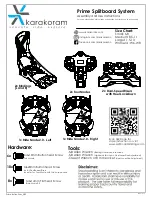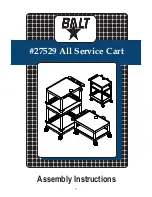
Stress Testing the Line
1. Make sure that all connections are tight and secure.
2. Suspend either a 250 lbs. (113 kg) weight or a person from 5 ft. (1.5 m) on each end of the slackline.
The line should securely hold the weight in place with very little give.
NOTE: Any bystanders should maintain a safe distance of 10 ft. (3 m) from the person performing the stress test.
Tips for Using the Slackline with Obstacles
• Set up a step ladder at the beginning and end of the course.
• When starting out, it may be helpful to start with the slackline in a lower position,
so that the user can stand on the tips of their toes while they get used to using each obstacle.
• Do not expect to be able to complete the course on the first few tries.
The more you use the course, the more your muscles will develop, making the course seem easier.
• For added difficulty, try adding more obstacles or increase the space between each obstacle.
5
Care and Maintenance
At the beginning of the play season:
1. Tighten all hardware: check the line, ratchet, delta clips, and all connections for any sign of looseness, damage, wear,
fraying, or sharp edges and replace as needed.
2. Lubricate all metallic parts: use grease or lubricating oil to lubricate the delta clips for easy opening,
and the ratchet for smooth tightening.
3. Check all protective coverings on bolts, pipes, edges, and corners. If they are loose, cracked, or missing,
replace before use.
4. Check any wooden parts for deterioration and splinters. Sand down splinters and replace any
deteriorating wood parts.
5. Check all moving parts: check all grips for rust, wear, or other deterioration and replace as needed.
6. Check all metal parts for rust: if found, sand and repaint with a nonlead-based paint.
7. Loose-fill materials: maintain a minimum depth of 9 in. (23 cm) of loose-fill materials such as wood mulch/chips,
engineered wood fiber, or shredded/recycled rubber mulch for equipment up to 8 ft. (2.5 m) high, or 9 in. (23 cm)
of sand or pea gravel for equipment up to 5 ft. (1.5 m) high.
NOTE: An initial fill level of 12 in. (30.5 cm) will compress to about a 9 in. (23 cm) depth of surfacing over time.
The surfacing will also compact, displace, and settle, and should be periodically refilled to maintain a depth of
at least 9 in. (23 cm).

























